Introduction to Reports
infoodle allows you to search and display information relating to various aspects of your organisation. However, Reports produce information with a large scale design in mind, and can be fine tuned to show just the information you're looking for.
When creating the report parameters, you need to consider who are you interested in, from where you want to obtain the data (for example, a group), how you might group that data together, and what information you want to display.
Selecting the Report Area
Most reports are created using the same steps but there are some Special reports in infoodle which are slightly different. For example, Attendance.
-
Select Reports from the Navigation Menu.
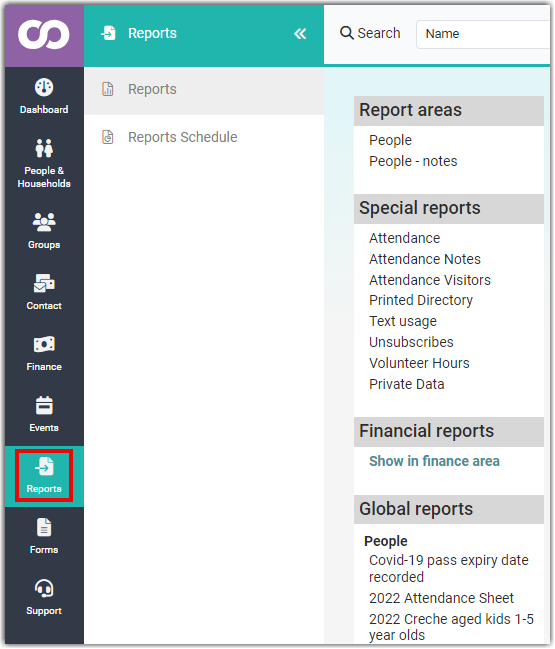
-
Select the type of Report to generate. Depending on the infoodle modules you've subscribed to, reports are generally based on People, Assets or People - Notes.. Other reports such as , Attendance, for example, can be found in the Special reports section.
The following information includes screen images relating to People reports - the creation of Asset or People - Notes reports is similar.
The ability to create People - notes reports is tied to the Notes options in Role permissions.
If a user's role does not have the permission Can see general people notes they will not have access to the People - notes report functionality at all, even if they can access People reports.
Similarly, if a person can see and report on Notes, but is not in the associated group that a Note maybe assigned to, any Note report they run will not list those Notes.
This is because the Visibility Access restrictions apply when viewing Notes System-wide - you can only report on Notes that you are ordinarily able to see.
The one exception to Note visibility is if a user has added the Note themselves, and set it as Visible to a Group, they will always see that specific note even if they are not part of that group. This is a very specific case where the person that added the note, is always able to see the notes that they have added, so long as their role has that permission enabled.
For further information regarding Roles and Notes, see Roles - Viewing Notes on other Contacts
Create Criteria
The Create Criteria tab is the starting point for selecting the data you want to display.
-
Select the drop-down and begin by choosing the criteria you want to add, or exclude from the report.
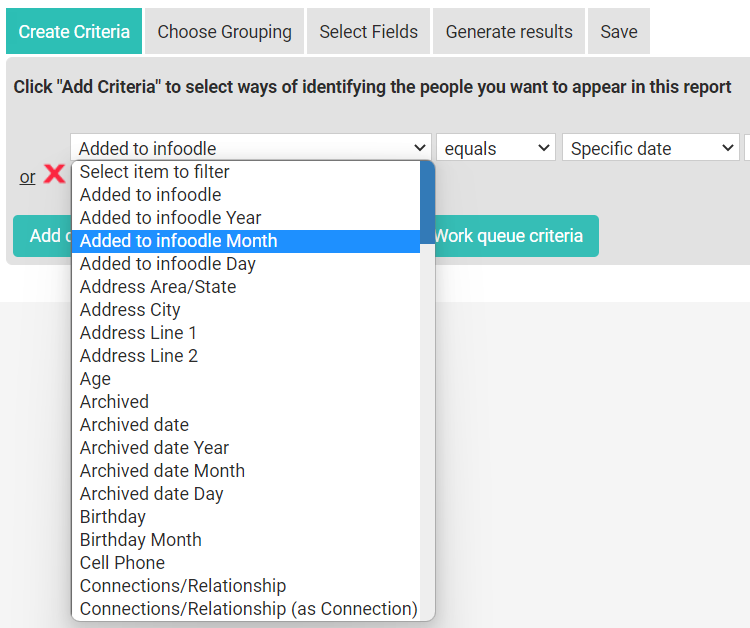
-
Once a criteria is selected a second drop-down specifies range filters relative to the selected criteria.
In the example below, the options specify an exact date, all dates before, and all dates after the specified date.
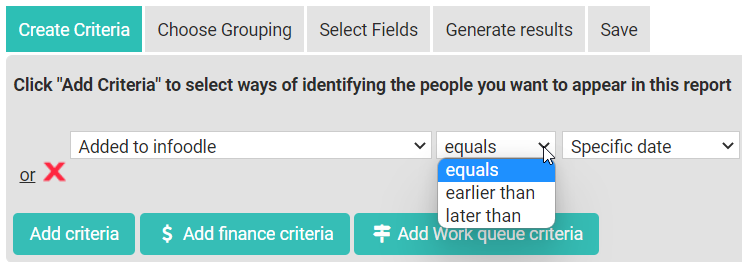
Other criteria ranges may filter results with:
- starts with, ends with, contains (Address)
- starting or ending numbers (of phone numbers),
- equals or does not equal (Groups)
-
The third field will be either a drop-down box for the selection from a list of related filters (specific age year when the Criteria is Age), or a text box for text you want to search for (a road name when the Criteria is Address).
Depending on the initial Criteria, additional fields may be displayed.
-
Continue adding Criteria using the Add Criteria button. This will provides the option of adding additional criteria with the AND function. When using the AND function the resulting list of contacts is generated based on all criteria being true. For example, if the criteria consists of:

the result will include only those that: live in Auckland and their birth month is September.
Another example:
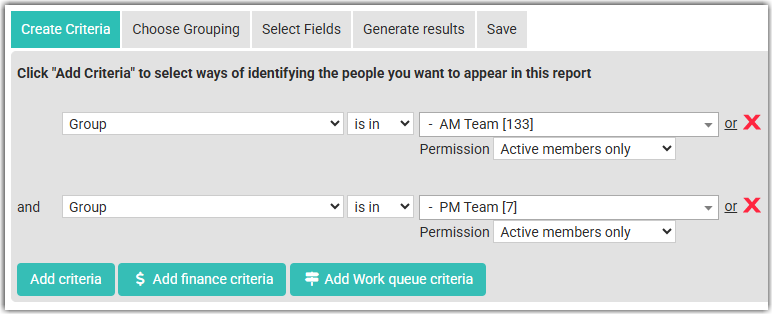
The result will only include contacts that are in both groups.
- If you are looking for people in one or more groups, for example,then make sure that you use the OR function (as in the screenshot below). To select the OR function add one criteria and then click on the or button to the left of the delete 'X' icon, to add another criteria.
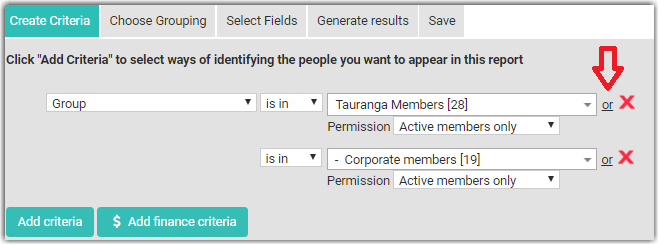
Financial Criteria
For Finance information, set a criteria to select the contacts of interest (or no criteria to select all contacts in your infoodle), then select Add financial criteria and select the required financial option or options to to refine the initial criteria.
For example, the criteria below selects all contacts add to infoodle later than 1/1/2021 and their transaction total is $60:

Date Criteria - Date Ranges
When you choose a date field, for example, Date of Birth, and you select equals, you are presented with a choice of how to set the date - either a Specific date or a list of Preset date ranges.
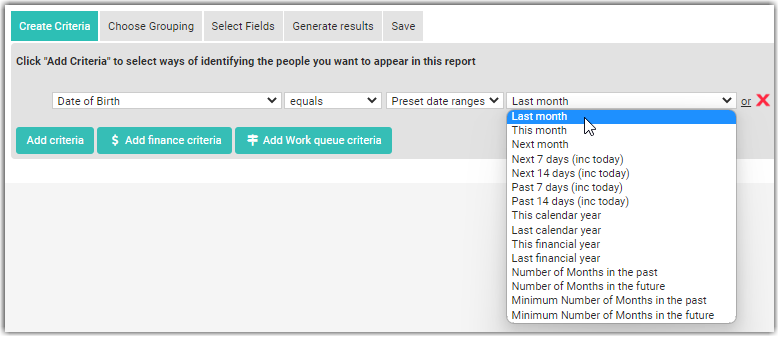
When selecting the operators Earlier or Later or Less than or Greater than, keep in mind this is exactly what is meant - not 'equal to' and 'Earlier', 'Later', 'Less than' or 'Greater than'.
For example, in the Financial Criteria example above, 'Added to infoodle later than 1/1/2021' would result in:
- all contacts added on or after 2/1/2021 - but not those added on 1/1/2021.
Choose Grouping
Once you have selected all of your criteria you have the option to select the options in the Choose Grouping tab. This provides you with the ability to select how you would like data in the Report to be sorted. This can improve the readability of the report.
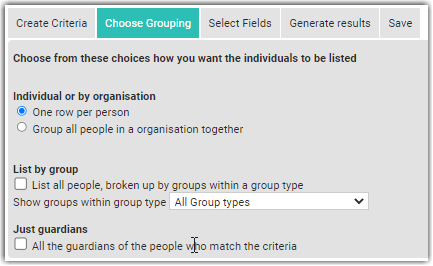
Select Fields
The Select Fields tab displays all of the data fields in your infoodle and provides you with the option to select what details you want to include in the report.

Generate Results
The Generate Results tab provides options for:
- Show - displaying the report directly on the screen
- Download options - exporting the report as an Excel or CSV file
- Further processing options
- use the report results as destinations for an email.
- add the results to an existing or new group. See Add to a group below.
- add the results to a Work Queue for later processing. See Add to an existing Work Queue below.
- Save report criteria - for information on this, see Saving a Report.
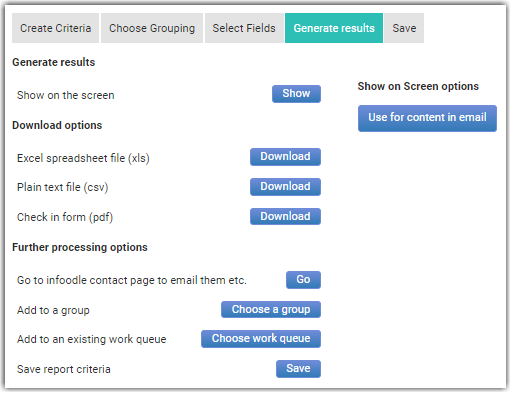
Add to a Group
Selecting the Choose a group button leads to a new screen where you can either add the report results (Contacts - either individuals, or organisations or households) to an existing group, or as the basis for the creation of a new group:
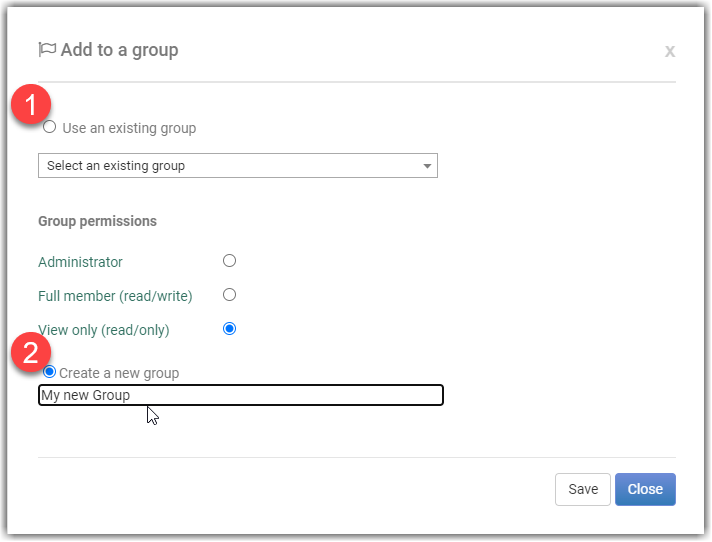
If you select the option to Create a new group, after you have entered a name for the new group and selected Save, the group, with the report results (individuals or organisations/households), will be created immediately.
Add to an existing Work Queue
A work queue is a list of people that require some manual processing. An example would be a follow up is required once a person has joined your organisation.
When you select this option the list of Work Queues that you have access to will be displayed:
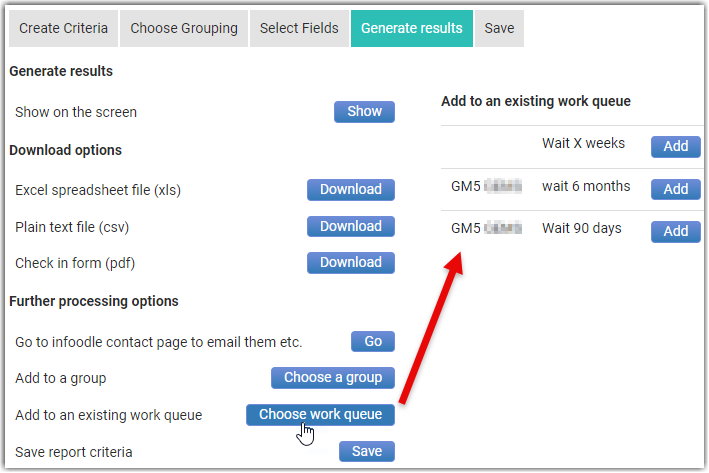
Select Add to add the report result contacts to the required Work Queue.
For information on printing the results, see: Printing a Report